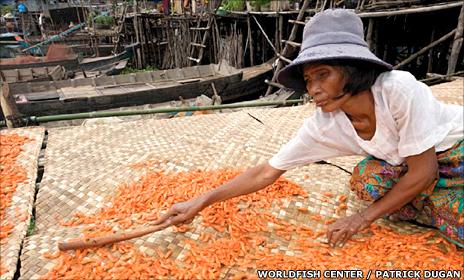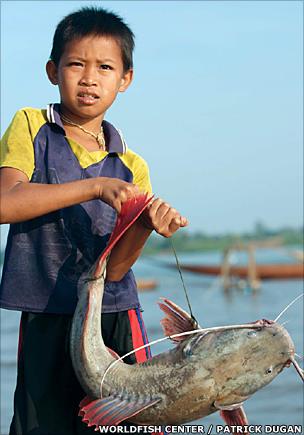River and lake fish 'neglected but essential'
- Published

The report argues that biodiversity is key to keeping critical fisheries afloat
Inland fisheries provide employment for more people than their marine equivalents, as well as being a vital source of nutrients, a study concludes.
The UN-backed Blue Harvest study says that in Africa alone, fish from rivers and lakes are a key source of protein and minerals for 100 million people.
However, dams and other kinds of water management have drastically reduced yields, particularly in Europe.
Properly valuing these fisheries could lead to better forms of management.
The study was launched at the UN Convention on Biological Diversity meeting here.
It puts the yield of fish from these predominantly freshwater sources at 13-30 million tonnes per year.
In terms of quantity, that is dwarfed by the amount coming from the oceans and aquaculture, which produce in the region of 50 million tonnes annually.
But because inland fishers generally deploy low-tech methods and use the fish for local consumption, the employment benefit is somewhat higher.
The UN Environment Programme (Unep) says this is the first study to bring together inland fisheries data from across the world.
"This fascinating report has brought to the fore the often neglected subject of inland fisheries," said Unep's executive director Achim Steiner.
"While marine fisheries are under increasing scrutiny, those based on river and lake systems rarely engage the international community - an oversight of potentially profound implications."
End of the line
That scrunity is one of the factors that have led to governments, and fishing communities themselves, to take action to conserve marine fish stocks.
But in inland fisheries, the situation can be more complex.
Dams and other modifications of waterways can have big and unintended consequences for these fisheries, while communities and industries alongside can also disturb them with pollution.
"If you look at Japan, or countries around Europe that used to have commercial inland fisheries, they now don't exist," said Yumiko Kura of the WorldFish Center, a UN-supported research institute based in Malaysia.

Upstream dams can have dire downstream consequences
"The level of modification done to freshwater lakes and rivers has a lot to do with the productivity of those systems - many freshwater species are migratory, and connectivity between river systems and betwen rivers and the sea is very important."
Where inland fishing is possible in industrialised countries, she noted, it is usually for recreation rather than staple food, and often supported by the regular release of juvenile fish.
Basin cut
To illustrate the point, Blue Harvest compares the health of the salmon populations in two of North America's largest river systems, the Fraser and Columbia, which both supported major fisheries until the early 1900s.
Since then, nearly 150 dams have been built on the the Columbia and its tributaries; the Fraser has just a handful.
The Fraser is recognised as the biggest salmon-producing river basin in the world, while on the Columbia, most populations are under government protection, and have to be supported by hatcheries, the addition of measures such as fish ladders, and the regular transportation of fish between different parts of the basin.
The report warns that unless modifications in major developing world rivers such as the Mekong are carried out in ways that allow fish to flourish, there will be a decline in catches essential for millions of people.
This does not mean that dams and other infrastructure should not be built, it concludes - but that development must be appropriate, and decisions made only after properly assessing the economic, nutritional and social benefits of the fisheries.
A related concern, said Ms Kura, was preserving the diversity of inland water systems such as the Mekong, where fishers catch on the order of 500 different species.
"When you look at the fisherman's net, there are countless species in it - they don't rely on any particular one, but on all of them," she said at the launch here.
"In some years, certain species might not be available but other ones are, because different species have different ways of responding to environmental changes - so biodiversity is key to sustaining the vitality of the fishing industry."
- Published21 October 2010
- Published20 October 2010
- Published20 October 2010
- Published18 October 2010